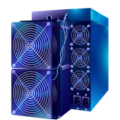Asic Miner Profitability
Our mining profitability calculator helps users quickly pinpoint the most lucrative mining options by delivering real-time data in multiple fiat and cryptocurrency currencies, including USD, EUR, GBP, AED, CAD, AUD, THB, ETH, and BTC. It allows precise electricity cost inputs up to three decimal places for highly accurate profit estimations. Users can access a clear overview of top-performing miners, algorithm-specific performance tables, and visually organized listings of mineable coins with recognizable cryptocurrency icons, simplifying decisions for maximum returns.
| Model | Hashrate |
Profitability
Profit
|
|---|---|---|
|
Bitmain Antminer DR7
127TH/s
|
127 TH/s |
$-1.53/day
|
Our cutting-edge mining calculator offers comprehensive insights across all major cryptocurrency algorithms, helping users easily identify the most profitable options for their specific hardware. The algorithm data is continuously refreshed to keep pace with the dynamic crypto mining industry, providing accurate evaluations based on real-time profitability statistics and overall market activity. This empowers users to make well-informed choices that reflect the latest mining conditions and algorithm performance.
Bitcoin Mining Difficulty
Monitor the latest Bitcoin network difficulty metrics in real time, including block times & estimated time until the next difficulty adjustment.
Progress
Current progress:
61.51 %
Remaining Block
Blocks Left:
776
Remaining Time
Time Left:
~ 5 days 1 hours
Next Change
Upcoming change:
6.9 %
Block Time
Current Block Time:
9.4 minutes
What is Blake256r14 algorithm?
Why Should You Rely on Our Profit Calculator for Accurate Mining Insights?
Blake256r14 powers the Proof of Work layer of Decred and was engineered for fast, verifiable hashing. It runs 14 rounds that harden the state against differential and rotational shortcuts. Its structure follows the HAIFA paradigm and adds a counter and salt to remove length-extension pitfalls seen in older schemes. The design comes from the BLAKE family that reached the SHA-3 finals after extensive public scrutiny. Addition, rotation, and XOR dominate the mix function, so the code maps cleanly to CPUs, GPUs, and custom silicon. The function is compute bound and uses little memory, which favors compact, high-frequency ASIC datapaths. Decred selected this algorithm to harness specialized hardware and to gain higher throughput with better energy per hash. Network security does not rely on hashrate alone, because Decred’s hybrid model lets ticket voters validate or reject blocks. This second check raises the cost of deep reorgs and blunts the leverage of a majority miner. On real machines, modern firmware tunes clocks, voltage, and fan curves to maximize hashes per watt under changing temperature and work patterns. Controllers profile chip quality and set stable per-board targets that avoid throttling. Pools deliver work through Stratum, and miners expand the nonce space with an extranonce to keep engines busy. Effective throughput depends on network difficulty, accepted share rate, stale share rate, and uptime. Profit projections improve when you include device hashrate at the chosen frequency, wall power, pool fees, local energy rate, expected maintenance downtime, and the present difficulty level. Monitoring that tracks difficulty swings, error counters, and rejected shares helps catch marginal settings before failures spread. Blake256r14 emits deterministic 256-bit digests, and standard test vectors allow straightforward verification. The deterministic structure enables simple hardware checks and lightweight fault detection. Sustained efficiency improves when farms use clean power delivery, low-impedance cabling, and airflow that holds junction temperatures within a tight band. Under that discipline, the algorithm turns electricity into ordered proof at scale like a quiet foundry casting blocks of time.
Latest ASIC Miners
Check out the latest ASIC miners added to our site. These are the newest listings, featuring the most recent models.
V3
Nerdminer
AE3
IceRiver
Antminer L11 Hyd 2U
Bitmain
Why ASIC Mining?
The Advantages of ASIC Mining Compared to Other Mining Types
ASIC (Application-Specific Integrated Circuit) mining involves specialized hardware designed exclusively for mining cryptocurrencies like Bitcoin, offering unmatched efficiency and performance. Unlike general-purpose GPUs, ASICs are optimized for specific algorithms, delivering significantly higher hashrates while consuming less power per hash. This makes them far superior for mining tasks, as they maximize profitability by reducing electricity costs and increasing mining output. ASIC miners are purpose-built, providing stability and reliability in high-demand mining environments, unlike GPUs which are prone to overheating and wear during prolonged use. Their compact design also allows for easier scalability in large mining operations. By focusing solely on mining, ASICs eliminate the overhead of multi-purpose computing, resulting in faster block-solving times. This efficiency translates to higher rewards, making ASICs the preferred choice for serious miners aiming to stay competitive in the cryptocurrency market. In contrast, GPU mining, while versatile, cannot match the raw power and cost-effectiveness of ASICs for dedicated mining tasks.
Optimized for Mining
Energy Efficient
Reliable & Stable
Scalable
More about the Blake256r14 algorithm
See how our profit calculator delivers accurate, real-time mining insights, helping miners make informed decisions.
Blake256r14, the 256-bit, 14-round ARX (add-rotate-xor) hash at the heart of Decred’s Proof of Work and rooted in the HAIFA construction, turns raw computation into a disciplined signal: modern implementations drive GPU SIMD lanes and warp-level parallelism to full occupancy with careful loop unrolling, rotate intrinsics, and register budgeting that suppress branch divergence and idle cycles, while on ASICs and FPGAs the algorithm’s compact state and round regularity enable deep, deterministic pipelines, clock gating, and retiming so that firmware and microcode upgrades slot in cleanly without destabilizing consensus or the wider network; security follows from design and practice, as HAIFA’s counters and optional salts counter length-extension attacks, the table-free ARX core supports constant-time, cache-independent code, and hardened variants add masking or blinding of intermediate words, nonce-walk randomization, power-delivery smoothing, and telemetry that watches for correlations suggestive of timing, power, or EM leakage. As a SHA-3 finalist, BLAKE’s cryptanalytic pedigree is well-charted, and Decred’s choice to forgo ASIC resistance is strategic: the algorithm’s low memory footprint and predictable control flow translate into high throughput per watt and stable thermals on specialized hardware, improving network security and scalability through sheer, measurable capacity; seasoned operators tune voltage-frequency curves, enforce thermal ceilings with calibrated fan and VRM headroom management, and favor efficiency points just shy of maximum clocks to limit soft error rates and silicon aging under continuous load. At the software edge, stratum clients precompute midstates, expand nonce space with extraNonce fields, and batch submissions to cut host-device overhead, while device kernels prioritize coalesced memory access, shared-memory staging for message scheduling, and occupancy targets matched to scheduler granularity so streaming multiprocessors stay saturated; across fleets, latency-aware pool selection and disciplined time synchronization suppress stale shares and smooth reward variance. In Decred’s hybrid design, PoW’s hardware-optimized hashing is counterweighted by stakeholder voting that moderates finality and raises the bar for majority attacks, so that even stress and near-failure-thermal excursions, timing margins, variance spikes-become revelation rather than ruin, illuminating where to thicken the pipeline, tighten the loop bounds, or widen the monitoring, and reminding practitioners that every incremental gain in constancy, throughput, and observability is not just performance but structure fortified against the kinds of shocks a maturing network must survive.
 English
English
 German
German
 Hungarian
Hungarian
 Dutch
Dutch
 Spanish
Spanish
 French
French
 Italian
Italian
 Czech
Czech
 Polish
Polish
 Greek
Greek



















